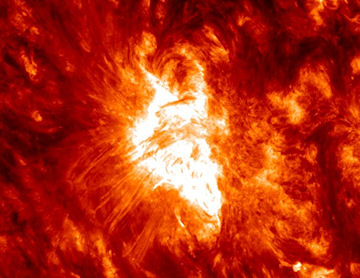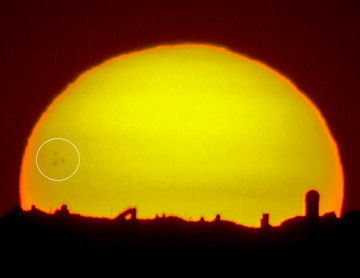ANDROID FLYBYS: Our field-tested satellite tracker is now available for Android phones. Features: Global predictions and flyby alarms! Learn more. | | | LAST X-FLARE: Can you remember the last time the sun produced an X-class solar flare? (Spoiler alert: The answer lies two sentences hence.) X-class flares are the most powerful kind of solar eruption, and during years of solar maximum they can occur on a daily basis. The most recent X-flare occurred on Dec. 14, 2006, almost four years ago. That last gasp of decaying Solar Cycle 23 marked the beginning of a deep solar minimum that is only now coming to an end. When will the first X-flare of Solar Cycle 24 explode? You could be the first to know. ULTRAVIOLET SUNSPOT: Sunspot 1089 is churning out a lot of extreme ultraviolet (EUV) photons. Witness this EUV image taken just hours ago by the Solar Dynamics Observatory: 
The bright glow comes from hot (80,000 K) plasma trapped by the sunspot's magnetic field. All by itself, this one 'hot spot' is lifting the EUV brightness of the entire sun toward a high point for the year. EUV photons from sunspot 1089 are absorbed in Earth's upper atmosphere where they heat the rarefied air and help reverse the recent collapse of the thermosphere. Sunspot 1089 is still growing, both in brightness and area. Readers with solar telescopes are encouraged to monitor developments. more images: from Etienne Lecoq of Normandy France; from Roman Vanur of Nitra, Slovakia; from Pavol Rapavy of Observatory Rimavska Sobota, Slovakia; from Steve Wainwright of Gower S.Wales UK KITT PEAK SUNSET: Sunspot 1089 has grown so large, it can now be seen without the aid of a specialized solar telescope. Yesterday, Gil Esquerdo "spotted it" as the sun set over Kitt Peak, Arizona: 
Photo details: Canon 20Da, ISO 100, 1/8000s exposure
Esquerdo was located on adjacent Mt. Hopkins. "Twice a year, the sun sets behind Kitt Peak as seen from the ridge on Mt. Hopkins and the Whipple Observatory," he says. "Our monsoon thunderstorms cooperated long enough for me to photograph the event." Kitt Peak is home to more than a dozen world-class telescopes, and many of their silhouettes can be seen in Esquerdo's photo. Highlights include the triangular profile of the great McMath-Pierce solar telescope and the towering dome of the WIYN 3.5m telescope. Warning: Although sunspot 1089 is large enough to see with the naked eye, looking for it is not recommended. Even when sunlight is dimmed by clouds and haze, you can still suffer permanent eye damage by staring too long at the unfiltered sun. Be careful.
Solar Eclipse Photo Gallery
[NASA: South Pacific Eclipse] [animated map] | 
